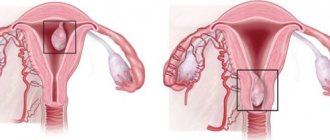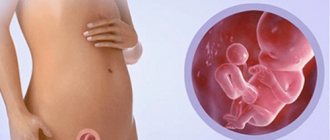Any deviations in health while carrying a baby frighten expectant mothers. After all, they are responsible not only for themselves, but also for their defenseless babies. This means that you should immediately consult a doctor if any embarrassing symptoms appear. One of these manifestations is beige discharge in early pregnancy.
Physiological changes in the body in early pregnancy
Female secretion is a normal phenomenon, including during pregnancy. But it is important to learn to distinguish ordinary physiological options from pathological ones.
Vaginal secretion is a rather complex product in its composition. It contains mucus as a base, which is formed by the glands of the cervical canal, as well as condensed cells of the stratified epithelium, which is located on the walls, and microorganisms that every girl normally has (they are distinguished by a large number of lactic acid bacteria).
Such mucus is necessary to maintain a normal level of microflora, protecting it from the entry of pathogenic variants; leucorrhoea also allows you to maintain the self-cleaning regime of the vagina and moisturizes during intimacy. They can be different in consistency - it all depends directly on the day of the cycle.
After a certain time after conception has taken place - experts understand this period to be 10.11-14 days - the appearance of female discharge begins to change. At the same time, they remain completely physiological and normal. Against the background of active hormonal changes that have begun, the expectant mother develops thick, opaque and at the same time quite small in volume leucorrhoea. Such suspicions do not arouse doctors, and no one tries to treat them.
But if beige discharge appears instead of whitish, and even in the early stages, you should be wary. First of all, to the woman herself, and then to the doctor to whom she turns with such a problem. It happens that they are a variant of the norm, but still more often they talk about certain disorders in the entire process.
https://youtu.be/CFz31deHdq4
Is beige discharge dangerous?
The appearance of mucus that is different in color from what appears normal can be a red flag. After all, this often indicates that something is going wrong.
The list of problems due to which the color of mucus may change:
- ectopic pregnancy (it should be accompanied by additional pain in the lower abdomen, which is quite severe, nausea and minor bleeding);
- detachment of the fertilized egg: because of this, slight bleeding occurs inside the uterus, which turns the leucorrhoea into a characteristic beige shade;
- sexually transmitted infections;
- erosion of the cervix: it also often bleeds, which causes the appearance of beige secretion.
If drops of blood or streaks appear in the white discharge, you should also consult a doctor as soon as possible. Especially if this is accompanied by nagging and aching pain in the lower abdomen and lower back.
The main danger of such discharge is the fact that the risk of miscarriage increases. In this case, there must be additional symptoms that indicate that the situation is critical.
When discharge is a sign of an inflammatory process
Beige discharge at the beginning of term is an ambiguous phenomenon. And there are situations when they signal a threat to the fetus. Doctors say that these can appear in several different pathological cases.
Thus, they indicate the presence of inflammatory processes in the body of the expectant mother. They cannot be ignored, because... they can jeopardize the entire pregnancy. Due to the presence of bacteria, the secretion may acquire a characteristic beige-light or dark shade.
Usually the inflammatory process is accompanied by additional symptoms, including:
- unpleasant and pungent odor;
- plentiful volume;
- cottage cheese consistency;
- dark beige color.
Beige discharge with additional painful symptoms indicates the development of a problematic process, which means it requires medical intervention and is dangerous for both the expectant mother and the embryo.
When you don't have to worry
Beige discharge can also be completely harmless. They can be a consequence of hormonal processes. In the early stages, there is an increase in the level of characteristic hormones that are required so that the pregnancy can take hold.
As a result, a large amount of mucus is formed under the influence of progesterone. The problem can be solved simply - you need to use panty liners, change them as needed and observe the color of the discharge. If they are still light, then it’s not scary.
Coffee-colored discharge may appear at week 5 due to the formation of a mucus plug, which will protect the baby from infections and close the uterine cavity for the rest of the period.
In the first trimester of pregnancy, a light beige secretion may also appear as a result of egg implantation. During the movement of the fertilized egg and its attachment to the wall of the uterus, small and non-life-threatening bleeding often occurs, which stains the leucorrhoea. But here it is important to understand that such a phenomenon should not be long-lasting and not too abundant. The main thing here is that the mucus is not accompanied by itching, burning and an unpleasant odor.
Darkened leucorrhoea after examination by a gynecologist or an ultrasound procedure is not dangerous. In the early stages (7-12 weeks and later), doctors practice transvaginal options, which is penetration through the vagina with a sensor. As a result, microcracks may form and bleed. Because of this, the color of the leucorrhoea changes. But this should happen almost immediately.
A beige secretion sometimes appears on days when menstruation was scheduled to occur. These are also hormonal games. True, it is worth understanding that slight changes in the color palette of the secretion can only be observed in the 1st trimester, when the entire organism as a whole is actively restructuring.
Beige discharge during early pregnancy without pain can also appear as an allergic reaction. Again, all because of the same hormones, the sensitivity of the female intimate sphere may change.
As a result, the expectant mother will begin to react sharply to washing powders, bleaches, fabric softeners, etc. In this case, the situation normalizes after the irritant is eliminated.
What to do if beige discharge appears - tips for expectant mothers
The first thing to do is not to hope for chance, but to go to the doctor. He will conduct an examination and prescribe all the necessary tests. These can be smears for infections and various microorganisms. A fungal test will also be carried out. Based on the results of these tests, medications will be prescribed to correct the situation.
If the discharge becomes thicker, becomes more intense in color, is accompanied by pain and other characteristic symptoms, the expectant mother may be offered hospitalization.
Doctors advise taking care of prevention, which will avoid many unpleasant moments. A woman should carefully monitor her health, eat right, and not be overcooled or nervous.
Also among the preventive measures is the selection of cotton underwear, which will reduce the risk of developing thrush and various irritations. In addition, the expectant mother should avoid stress, which can also cause disruptions in the normal course of the process. And of course, there should be no self-medication.
For general information, here is a useful video about dangerous discharge in women:
Diagnosis and treatment of the disease
Diagnostic measures consist of taking a series of tests and conducting an ultrasound examination. An analysis of venous blood and vaginal microflora is taken. Blood is examined for qualitative characteristics. The presence of diseases is accompanied by an increase in the number of leukocytes, lymphocytes and monocytes. Antibodies may also be detected.
The smear is examined for bacterial quantitative composition. Sowing is done in a special container. The proliferation of microflora makes it possible to quickly detect pathogenic bacteria.
An urgent ultrasound examination is also necessary. The doctor uses a device to determine the condition of the ovaries, chorion, placenta, and fetus. Only after a complete diagnosis is treatment selected. Therapy should not harm the baby or mother. For this purpose, treatment is carried out only under medical supervision. If a woman’s condition does not recover for a long time, hospitalization is required. Further therapeutic measures are carried out in the hospital.
https://youtu.be/RdV16L73Imc
Prevention is considered the best way to protect against diseases during pregnancy. A woman should take care of her health. Great physical activity is not allowed. You need to maintain psychological peace. Only these factors will help you safely carry and give birth to a healthy baby.
Yellow discharge in early pregnancy is normal
Experts clearly agree that yellow discharge may be physiological or normal for a pregnant woman’s body. However, this is only possible if the following conditions are met:
- the discharge has a light yellow or cream tint;
- there are no sharp or unpleasant odors;
- discomfort in the form of burning and itching in the vaginal area and vulvar mucosa (external genitalia) is excluded;
- There are no signs of intoxication or other pathological symptoms.
Yellow discharge can signal changes occurring in a woman’s body: a cervical mucus plug is formed and hormonal changes are observed.
If yellow discharge appears during pregnancy, but there are no other negative symptoms, then they are usually considered to be a physiological norm. However, consultation with a specialist is necessary in any case, since not all diseases manifest themselves clearly.
Yellow discharge can be formed due to the individual characteristics of a woman’s body or be considered as a relative norm, namely, the result of non-compliance with intimate hygiene, or its irregularity.
The appearance of a yellow tint can also be affected by:
- products used for personal hygiene of intimate areas;
- synthetic underwear;
- panty liners that are impregnated with chemicals or aromatic substances.
Table: yellow discharge is normal by week
| Week of pregnancy | Discharge is normal |
| week 6 | It is normal if the discharge is clear and uniform in structure and is not accompanied by an unpleasant odor, itching, pain or other discomfort. |
| week 7 | If the discharge is not accompanied by clinical symptoms, then this is normal. At this stage, they may be mucous and vary in abundance. The dynamics of the structure of the secretion, its color and the appearance of an unpleasant odor is a bad sign that requires the intervention of specialists |
| 8 week | Discharge in moderate quantities, without an unpleasant odor, which is not accompanied by itching and other discomfort can be considered the norm. During this period, pregnant women often develop thrush. This occurs because the pH in the vagina becomes more acidic in an attempt to protect the fetus from various infections, and immunity decreases. Watery, yellowish discharge may appear due to leakage of amniotic fluid. If the secretion has a sweetish odor, then you should immediately consult a doctor |
| Week 9 | For this week, clear yellowish secretion is normal, without impurities or foreign odors. |
| 10 week | Yellow discharge during this period should have a uniform structure, be moderate and light in color. Other clinical symptoms are an indicator of the development of pathology |
| 11–12 weeks | Secretion without discomfort in moderate quantities is quite acceptable |
| Week 13 | During this period, discharge may become thinner as the young mother’s body begins to actively produce estrogen (a hormone produced by the ovaries), which helps thin the mucus. |
Therapeutic techniques
If the cause of the appearance of beige discharge is a disease, then only the attending physician should develop a treatment method. Most often you have to resort to the use of medications. Their dosage and course duration are calculated individually. A woman must strictly follow all doctor’s instructions and not exceed the recommended dosages of medications.
In some cases, the separation of beige secretion is provoked by a change in the concentration of progesterone levels. In this case, the specialist selects an appropriate treatment program if necessary. Among the measures to restore hormonal levels that a woman can take on her own are:
- Try not to buy food packaged in plastic wrap. If you still had to buy them, as soon as you bring them home, take them out immediately. Research by scientists has shown that such packaging facilitates the penetration of xenoestrogens into food. These substances lead to a slowdown in the synthesis of a woman’s own progesterone. In addition, plastic packaging may contain phenol. It can accumulate in the human body and have a detrimental effect on the hormonal system.
- Avoid using a microwave oven during pregnancy. If this is not possible, then use only glass containers to heat food.
- Use well-purified water for cooking. It is best to install a home water filter.
- Do not use hair dye or other chemical dyes. Try to minimize contact with painted surfaces.
- Rest should be complete. It is recommended to sleep at least 8 hours at night. If you can't sleep, do a light massage of the collar area. It will help you relax. You can also use breathing exercises.
- Introduce foods into your diet that promote progesterone production. These include: legumes, nuts, dairy products, lean meats, chicken eggs, oatmeal, whole grains, raspberries, avocados, olives.
In addition to the treatment suggested by the doctor, you can also use traditional medicine. Sometimes such compositions can lead to an allergic reaction, so before using them you should consult a specialist.
Note! One of the important aspects of treatment is maintaining immunity. To do this, your doctor may prescribe a vitamin-mineral complex. In addition, try to eat more fresh vegetables and fruits, do light exercises for pregnant women and walk more in the fresh air. All this allows you to strengthen the body’s protective functions and reduce the likelihood of developing diseases.
The appearance of beige discharge during pregnancy is a signal from the body about changes occurring in it. If they are not accompanied by other signs, then there is no need to worry about the baby’s well-being. In any case, it is necessary to consult a doctor.
Any deviations in health while carrying a baby frighten expectant mothers. After all, they are responsible not only for themselves, but also for their defenseless babies. This means that you should immediately consult a doctor if any embarrassing symptoms appear. One of these manifestations is beige discharge in early pregnancy.
Light yellow, beige, yellowish odorless discharge during pregnancy
Light yellow discharge is most often visualized during the first 3 months of pregnancy. This process is natural and is often caused by an increased level of progesterone (a steroid hormone) in a woman’s body. It activates blood circulation in the pelvic area and provokes the formation of secretion in large volumes.
Photo gallery: discharge during pregnancy
Light yellow discharge may appear due to the formation of a lump of high-density mucus in the cervix. If a woman is not bothered by the symptoms characteristic of pathologies: itching, burning, pain, discomfort, then most likely the secretion is a manifestation of physiology. At the end of 3 months of pregnancy, the amount of mucus should decrease. This is typical for most cases.
Intense yellowish discharge may be normal, but only if it is not accompanied by unpleasant symptoms. Abundant secretion is typical for many women during pregnancy. The walls of the uterus soften, and the composition of the vaginal environment changes. Increased secretion is necessary for the birth process to go smoothly.
The first trimester of pregnancy is the most important and is associated with active restructuring of the body. During this period, the fetus is most vulnerable. Beige secretion most often appears at the moment when the amount of the hormone progesterone in the blood increases sharply and the process of formation of a mucus plug occurs. If the resulting secretion has no odor, then we are talking about the norm.
What does discharge in the first trimester of pregnancy indicate?
The first trimester of pregnancy is the most important. It is at this time that the fetus is most vulnerable. The appearance of discharge at such a moment can be either normal or pathological. The following problems can be classified as physiological:
- Beige discharge in early pregnancy may appear due to a sharp increase in progesterone levels in the blood. This is a normal reaction of the body. The secreted secretion moisturizes the mucous surface of the genital organs.
- If the discharge is light beige, this may indicate the formation of a mucus plug. In this case, the separated secretion is colorless and odorless.
- In the first weeks of pregnancy, the egg is just beginning to implant. At this time, it can damage the mucous surface of the uterus. Because of this, dark beige or even brown discharge appears.
- After week 20, there is a sharp increase in estrogen levels. This leads to the appearance of scanty mucous secretions.
If you notice the discharge described above during early pregnancy, then there is no need to worry. This is a normal reaction of the body to new living conditions. But there are also a number of situations that cannot be called the norm:
- Dark beige heavy discharge can be evidence of an ectopic pregnancy. In addition, their appearance may be associated with erosive changes in the cervix.
- If beige discharge appears during early pregnancy with an unpleasant odor, this indicates the presence of an infectious disease, for example, candidiasis or papilloma virus.
Note! If such a problem occurs, you should consult your doctor. Only a specialist will be able to correctly determine the danger of discharge and, if necessary, develop a treatment program.
If everything is in order with the pregnant woman’s health, then no other symptoms other than secretion are observed. If pain, burning or itching occurs, you should immediately consult a doctor.
Dangerous yellow discharge during pregnancy: dark yellow, yellow-green, with odor and itching
Dark yellow discharge can occur against the background of the development of inflammatory processes in the genital organs. They are caused by various pathogens: Escherichia coli, staphylococci, diplococci, and so on. Most often they manifest themselves as discharge with a strong unpleasant odor.
Please note: it often happens that the infection enters the body even before the moment of conception, but subsequently begins to progress rapidly. That is why the issue of pregnancy planning must be approached responsibly. Before conceiving, partners must be diagnosed and treated for all ailments that could cause potential harm to the baby or the pregnant mother.
Discharge of a pronounced yellow-green hue can accompany infectious diseases such as trichomoniasis, gonorrhea, bacterial vaginosis, chlamydia and others. Often such secretion not only has an unpleasant odor, but also contains streaks of blood. In addition to these symptoms, itching of the genitals and burning sensation when urinating may be observed. Yellow-green secretion is a reason to urgently consult a doctor.
Yellow-green discharge is a sign of the development of an infectious disease in the pelvic organs
Important: only a specialist can determine the nature of the discharge and its nature. Self-medication during pregnancy is completely excluded. The same can be said about ignoring your body's signals.
Video: what discharge should alert women?
What examination should be performed if beige discharge appears?
Beige discharge may not pose any danger, but it is necessary to consult a doctor. First of all, the specialist will interview and examine the patient. He must find out all the existing complaints, examine the condition of the genital organs, take a smear from the vagina and urethra.
The following diagnostic techniques are used to identify possible problems:
- Biochemical and general blood test.
- Examination of a blood sample for hormone levels and the presence of antibodies to infectious diseases.
- Selected smears are examined for the presence of pathogens. For this purpose, the method of bacteriological culture, PCR or microscopy is used.
- A smear taken from the vagina is examined for the state of microflora and cytology.
- Calposcopy is performed. During the examination, the walls of the vagina, as well as the vaginal part of the cervix, are examined using a special device. This method can determine the presence of pathologies in the early stages.
- Ultrasound examination of the pelvic organs.
Note! Only based on the results of all the studies performed, a specialist will be able to make a diagnosis. After this, an appropriate therapy technique will be developed.
Diagnostics, necessary tests
Even more interesting:
Sores around the head
Mouth ulcers hiv
In order to make an accurate diagnosis, it is not enough for a gynecologist to visually assess the shade and consistency of the discharge, as well as its smell. Various tests help to understand what caused the development of pathology.
To confirm or refute the condition, the patient is usually asked to take
- general blood analysis;
- clinical blood test;
- gynecological smear for flora.
Based on the results of the data obtained, it will be possible to understand with a high probability what exactly caused the abundant secretion. In some cases, the gynecologist recommends that a pregnant woman undergo an ultrasound examination or an extensive blood test.
Treatment
After the cause of the appearance of pathological yellow or beige discharge has been discovered, the doctor prescribes a treatment regimen. Its duration directly depends on the nature of the pathogen and the individual characteristics of the woman’s body. Drug therapy usually includes drugs with antibacterial, antifungal, antiviral action, in tandem with special vitamin formulations and immunostimulating drugs. The patient may also be prescribed medications to restore intestinal and vaginal microflora.
The sooner a woman consults a doctor, the more effective the treatment will be. Paying attention to changes in your own body will help you avoid many complications and negative consequences.
Prevention of pathological discharge
The following preventive measures will help prevent the appearance of discharge:
- correct diet. The foods consumed per day must contain all the beneficial vitamins and elements that the body needs for normal development and creation of reliable protection;
- moderate physical activity;
- complete rest;
- compliance with the rules of intimate hygiene, regular procedures;
- safe sex;
- refusal of underwear made of synthetic fabric;
- being in a state of calm, away from stressful situations.
If you follow the described rules, you can reduce the risk of pathologies during pregnancy several times. And also ensure normal development for the fetus.
Video: discharge during early pregnancy
Most women experience discharge during pregnancy, and the author of the article is no exception. If this is your first pregnancy, then any symptom can cause fear or anxiety, even such as heavy discharge with a yellowish tint. They appeared at 10 weeks of pregnancy and forced me to urgently consult a doctor. The structure of the secretion was transparent and homogeneous. The doctor assured me that there was nothing to worry about, but she took a gynecological smear for flora. The latter did not reveal pathologies. By week 11, the discharge returned to its clear state. However, by 13 they became more liquid and the characteristic yellowish tint appeared again. The doctor explained that this is due to changes in hormonal levels, and also advised me to change the brand of panty liners and the product used for intimate hygiene. By the 15th week, the discharge became less abundant, and by the 20th week it stopped altogether. From the situation I concluded that we should not draw hasty conclusions. Only a consultation with an experienced specialist will help you correctly interpret the signals coming from the body.
Discharge during pregnancy can be considered normal and should not always be a cause for panic. However, only a qualified specialist must establish this fact. This is the only way to avoid possible consequences and complications. After all, every woman’s body is individual. The expectant mother must understand that she is responsible for the health of the child.
In the article we discuss discharge during early pregnancy. We tell you why they arise, in which cases they are a physiological norm, and when they are a pathology. You will learn what beige secretion with and without pain in the abdomen means, reviews from gynecologists and women.
Prevention
The following measures will help prevent the appearance of pathological beige discharge:
- Compliance with the rules.
- Using cotton underwear.
- The use of contraceptives during sex with an unreliable partner.
- Regular visits to the gynecologist and compliance with his recommendations.
- Using fragrance-free intimate hygiene products.
While expecting a baby, a woman’s body undergoes serious changes, which primarily affect hormonal levels. During this period, vaginal discharge may appear that was not there before. Not all of them can be considered safe. Beige colors may indicate the development of serious diseases.
Physiological causes of beige secretion
During pregnancy, a woman's body works differently. In the early stages, the expectant mother may observe an increase and change in vaginal discharge, which is caused by an increase in the level of the hormone progesterone, which is necessary for bearing a child. Starting from the 2nd trimester, progesterone gives way to another hormone, estrogen, which can also affect the nature of mucous secretions.
Beige secretion should not cause discomfort
Experts highlight the physiological and pathological nature of discharge during early pregnancy. Physiological secretion should not cause any discomfort to a woman; its color is transparent or white. In this case, the discharge should not be accompanied by itching, burning or pain in the perineum or have an unpleasant odor.
Next, we will talk about the main types of physiological discharge that do not require special therapy and go away on their own.
Pathological causes of beige discharge
Vaginal secretion of a creamy color, accompanied by nagging pain in the lower abdomen, lower back, bloody impurities or a specific odor is a reason to consult a doctor. Such signs indicate the presence of serious diseases, which we will discuss below.
Infectious pathologies
Sexual infections cause beige secretion and can lead to termination of pregnancy. That is why it is necessary to start treatment as quickly as possible in order to avoid negative consequences.
The most dangerous conditions include:
- Sexually transmitted infections - sexually transmitted diseases always cause abnormal secretion (yellow, gray). Most often they are abundant, have an unpleasant odor, and cause itching and burning in the genital area. With gonorrhea, trichomoniasis, the secretion is purulent, yellow-beige, green. The presence of gardnerellosis and chlamydia is indicated by white-cream or light beige discharge.
- Endocervicitis is an inflammation of the mucous membrane of the cervical canal, accompanied by beige secretion.
- Vaginitis - hormonal changes and a decrease in the protective properties of the body entail a change in the microflora of the vagina and the development of nonspecific vaginitis. A characteristic feature of the pathology is a foul odor and beige discharge.
Cervical erosion
This pathology can cause a creamy beige smudge streaked with blood. Secretion may increase after sex, physical activity or bowel movement. An examination in a gynecological chair will help identify the disease.
Threat of miscarriage
Beige secretion mixed with blood often indicates placental abruption. Before such discharge, abdominal pain and breakthrough bleeding often occur, leading to the onset of a miscarriage. If a pregnant woman feels discomfort or a tugging sensation in her stomach, general weakness and uncharacteristic discharge, she should immediately call a doctor.
Ectopic pregnancy
Often, beige discharge indicates an ectopic pregnancy. This condition is life-threatening for the pregnant woman and requires surgical intervention. Unfortunately, it is not possible to save the child, but the correct and timely actions of doctors preserve the woman’s reproductive functions, thanks to which she will still be able to become pregnant in the future.
Treatment of pathological discharge should be under the supervision of a doctor
What kind of discharge may appear in later stages?
In the second and third trimester, discharge of different textures may appear. Most often, they indicate serious disturbances in the hormonal system, infectious diseases, and decreased immunity. You should consult a doctor in the following situations:
- Copious liquid light beige discharge. This phenomenon can serve as a symptom of rupture of amniotic fluid.
- Creamy secretion with an unpleasant odor. This may indicate the development of an inflammatory process, viral or fungal infection.
- with a pungent odor. They become a symptom of vaginosis. This is a disease that is caused by a disruption of the normal microflora of the vagina. If treatment is not started in time, the disease can provoke early labor.
- Beige-yellow discharge, which is accompanied by pain in the lower abdomen. This phenomenon can be caused by an inflammatory process occurring in the genitourinary system, as well as sexually transmitted diseases. Most likely, the inflammation began even before pregnancy, but proceeded in a latent form. The weakening of the immune system while waiting for the baby led to the fact that the disease began to progress.
- During pregnancy, the pregnant woman's immune system is weakened. A woman can easily pick up E. coli, staphylococcus or any other infection. In this case, beige discharge appears, which is accompanied by a feeling of discomfort in the lower abdomen. The secreted mucus irritates the skin of the genital organs. Infectious diseases can cause complications during childbirth, so it is necessary to get rid of them as soon as possible.
- Lack of progesterone in the blood is also dangerous. It is this hormone that is responsible for the normal course of pregnancy, reduces the tone of the uterus and has a beneficial effect on its growth. In addition, progesterone is involved in the formation of the child’s immune system. If it is not enough, beige discharge appears. They do not bring any discomfort, the woman does not feel pain. This problem can only be identified through laboratory testing.
Note! If beige discharge appears during pregnancy, you should immediately consult a doctor. Get examined and, if necessary, the doctor will select a treatment program for you.
Treatment
Many pregnant women are concerned about the question of when to see a doctor if they are worried about beige discharge, whether it should be done right away or should they wait until it stops on its own. You need to seek medical help immediately, since any delay can cost the life of both the fetus and the pregnant woman.
A woman should be especially alert to abnormal discharge accompanied by a specific odor. Additional negative symptoms may include pain in the lower abdomen, lower back, burning sensation and itching in the perineum.
It is strictly forbidden to self-medicate; only a doctor should make a diagnosis based on the research and complaints of the patient.
Reviews
Unfortunately, I often encounter the fact that pregnant women do not promptly seek help when beige discharge appears. Expectant mothers should take into account that such secretion most often indicates health problems or an abnormal course of pregnancy. Only surgical treatment will help maintain pregnancy, but not the use of drugs recommended by a pharmacist at the pharmacy.
Beige secretion during pregnancy is a common phenomenon. If it occurs within a few weeks of conception, it is most often a sign of attachment of a fertilized egg to the wall of the uterus. But if a fetid or rotten smell appears, you should immediately consult a doctor, as this most often means the presence of sexually transmitted diseases.
At 8 weeks pregnant I began to experience beige vaginal mucus. I was very scared and visited a doctor. It turned out that this was an allergic reaction to taking Duphaston.
Violetta, 32 years old
At 9 weeks of pregnancy, severe pain occurred in the lower abdomen and beige discharge appeared. I went to the doctor, got tested and had an ultrasound. It was all due to a frozen pregnancy.
Despite the fact that beige discharge during early pregnancy may be physiological in nature, if it appears, consultation with a doctor is still necessary. Take care of yourself and your baby, have an easy birth!











